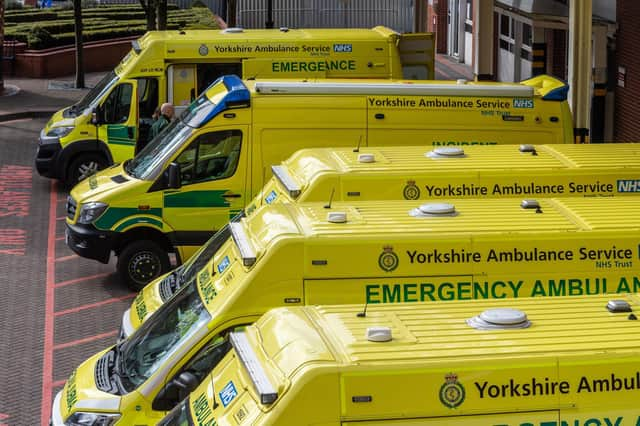Yorkshire Ambulance wait times for life-threatening injuries among highest in country as Leeds A&E demand continues to soar


Newly published data for October shows that the average response time for Yorkshire ambulances dealing with the most urgent Category 1 incidents – defined as life-threatening illnesses or injuries such as a cardiac arrest – was 11 minutes and four seconds.
This is compared with a target of seven minutes
The average response time in England was nine minutes and 20 seconds, while the highest was the South East Coast ambulance service which saw response times of 11 minutes and 48 seconds.
Advertisement
Hide AdAdvertisement
Hide AdFor Category 2 calls, such as burns, epilepsy and strokes, ambulances in Yorkshire took an average of 43 minutes and 40 seconds last month to respond.
This is less time than the England average of 53 minutes and 54 seconds.
Response times for urgent calls – such as late stages of labour, non-severe burns and diabetes – took on average two hours, 22 minutes and 25 seconds.
This is less than England's average of three hours, nine minutes and 58 seconds, which is the longest average since current records began.
Advertisement
Hide AdAdvertisement
Hide AdNHS England argued that 999 services had their busiest ever month in October as staff answered a record 1,012,143 calls.
75,480 of these called were answered in Yorkshire.
A spokesperson for Yorkshire Ambulance Service NHS Trust, said: “We are continuing to experience high demand for our services and we constantly monitor the situation.
“Our dedicated staff are working very hard to make sure patients can get the care they require and we continue to work closely with NHS partners in Yorkshire and the Humber to ensure there is a joined-up approach to patient care.
“We continue to remind the public to help us by only calling 999 in serious or life-threatening emergencies to allow us to focus our efforts on our most poorly patients.”
Advertisement
Hide AdAdvertisement
Hide AdRichard Webber, of the College of Paramedics and a working paramedic, told the BBC that his colleagues “have never before experienced anything like this at this time of the year”.
He added: “Every day services are holding hundreds of 999 calls with no-one to send.
“The ambulance service is simply not providing the levels of service they should – patients are waiting too long and that is putting them at risk.”
It comes amid claims of huge queues at the accident and emergency department at the LGI as senior hospital bosses urged people to seek help elsewhere if they can such as a GP, pharmacy or the NHS 111 service.
Advertisement
Hide AdAdvertisement
Hide AdMore patients visited A&E at Leeds Teaching Hospitals Trust last month, with demand rising above the levels seen over the same period last year.
NHS England figures show 30,157 patients visited A&E at Leeds Teaching Hospitals NHS Trust in October.
That was a rise of 4 per cent on the 29,014 visits recorded during September.
This 50 per cent more than the 20,135 patients seen in October 2020.
Advertisement
Hide AdAdvertisement
Hide AdThe figures show attendances were above the levels seen before the coronavirus pandemic – in October 2019, there were 27,884 visits to A&E at Leeds Teaching Hospitals Trust.
The majority of attendances last month were via major A&E departments – those with full resuscitation equipment and 24-hour consultant-led care – while 37 per cent were via minor injury units.
A total of 68 per cent of arrivals were seen within four hours, against an NHS target of 95 cent.
2,202 patients waited longer than four hours for treatment following a decision to admit and of those, 48 were delayed by more than 12 hours.
Advertisement
Hide AdAdvertisement
Hide AdSeparate NHS Digital data reveals that in September the median time to treatment was 124 minutes and round seven per cent of patients left before being treated.
LTHT Clinical Director for Urgent Care, Dr Sarah Davey, said: "Over the last few months, the number of patients seeking treatment at our emergency departments has increased considerably.
"The most urgent and life-threatening cases take priority, which means that unfortunately people coming in with less urgent issues are experiencing longer waiting times and could be treated elsewhere.
"We’re asking everyone to think carefully before coming to our Emergency Departments and to check with NHS 111 before attending, as they’ll be able to advise where you need to go to get the right care.
Advertisement
Hide AdAdvertisement
Hide Ad"NHS 111 can direct you to the right service and help you make an appointment. These include urgent treatment centres or minor injuries units, where you can be diagnosed and treated for things like cuts, sprains, simple broken bones, infections and fevers, minor burns and other minor injuries.
"This will help free up capacity for those who really need emergency care.
Dr Davey added: “We’re urging the public to remember that hospital emergency departments are for life or limb emergencies, such as severe chest pain, difficulty breathing, significant head injuries or complex fractures.”
Across England, A&E departments received 2.2 million visits last month.
That was an increase of two per cent compared to September, and 36 per cent more than the 1.6 million seen during October 2020.